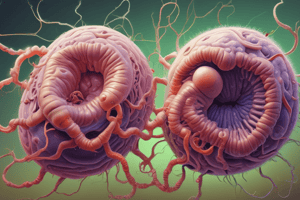Podcast
Questions and Answers
Flashcards
Parasitology
Parasitology
The study of the relationship between a parasite and its host.
Parasites
Parasites
Organisms that infect other living organisms, depending on the host for survival.
Host
Host
An organism that harbors the parasite, providing it with nourishment and shelter.
Medical Parasitology
Medical Parasitology
Signup and view all the flashcards
Ectoparasite
Ectoparasite
Signup and view all the flashcards
Endoparasite
Endoparasite
Signup and view all the flashcards
Free-Living Parasite
Free-Living Parasite
Signup and view all the flashcards
Obligate Parasite
Obligate Parasite
Signup and view all the flashcards
Facultative Parasite
Facultative Parasite
Signup and view all the flashcards
Zoonosis
Zoonosis
Signup and view all the flashcards
Definitive Host
Definitive Host
Signup and view all the flashcards
Intermediate Host
Intermediate Host
Signup and view all the flashcards
Paratenic Host
Paratenic Host
Signup and view all the flashcards
Reservoir Host
Reservoir Host
Signup and view all the flashcards
Accidental Host
Accidental Host
Signup and view all the flashcards
Vector
Vector
Signup and view all the flashcards
Biological Vector
Biological Vector
Signup and view all the flashcards
Mechanical Vector
Mechanical Vector
Signup and view all the flashcards
Carrier
Carrier
Signup and view all the flashcards
Vertical Transmission
Vertical Transmission
Signup and view all the flashcards
Study Notes
- Parasitology studies the relationship between parasites and their hosts
Parasites
- Organisms infecting other living organisms
- Depend on hosts for shelter, food and growth
Host
- An organism that harbors a parasite
Medical Parasitology
- Deals with parasites causing human infections and related diseases
Ectoparasite
- Resides on the host's body surface
- Does not penetrate the tissue
Endoparasite
- Parasite living inside a host's body
- Said to cause infection
Free-Living Parasite
- Nonparasitic active stages living independently
- Example: cystic stage of Naegleria fowleri
Endoparasites classification
- Obligate parasites like Toxoplasma gondii and Plasmodium
- Facultative parasites like Naegleria fowleri
Scientists Involved
- Antonie van Leeuwenhoek: First to use a single-lens microscope and observe Giardia in his stools in 1681 in Holland
- Louis Pasteur: Published first scientific protozoa study
- Prevented and controlled an epidemic silkworm disease in Southern Europe in 1870,
- Patrick Manson: Discovered mosquitoes role in filariasis in 1878
- First evidence of vector transmission
- Laveran: Discovered the malarial parasite in Algeria in 1880
- Ronald Ross: Discovered malaria transmission by mosquitoes in India in 1897
Definitive Host
- Host where the adult parasite lives and reproduces sexually
- Mosquitoes: Definitive host in malaria
Intermediate Host
- Host where parasite’s larval stage lives or multiplies asexually
- Parasites using humans as intermediate or secondary hosts include Plasmodium spp., Babesia spp., and Toxoplasma gondii
Paratenic Host
- Host where the parasite's larval stage remains viable without further development
Reservoir Host
- Host that maintains a parasitic infection in an endemic area.
- Acts as a significant infection source for susceptible hosts
- Dogs: Reservoir host for hydatid disease
Accidental Host
- Host not typically found to harbor the parasite
- Humans: Accidental host for cystic echinococcosis
Zoonosis
- Diseases and infections naturally transmitted between vertebrate animals and humans
Protozoal Zoonoses
- Toxoplasmosis, leishmaniasis, balanlidiasis, and cryptosporidiosis
Helminthic Zoonoses
- Hydatid disease and taeniasis
Anthropozoonoses
- Infections transmitted from lower vertebrate to man
- Example: cystic echinococcosis
Zooanthroponoses
- Infections transmitted from man to lower vertebrate animals
- Example: human tuberculosis to cattle
Exposure and Infection
- Pathogens: Harmful, causing mechanical injury to hosts
- Carrier: Harbors a pathogen without showing signs or symptoms
- Exposure: Process of inoculating an infective agent
- Infection: Establishment of the infective agent in a host
- Incubation Period: Time between infection and symptom appearance
- Pre-Patent Period: The time between infection acquisition and demonstration of infection
- Autoinfection: When an infected individual becomes their own source of infection
- Superinfection (Hyperinfection): Further infection intensifies the already parasitized individual with the same species
Infection Sources
- Contaminated soil, water and food
- Vectors that can be biological, where parasites develop/multiply, or mechanical, aiding transfer
- Soil with eggs penetrate uncovered skin
- Infected water transmits Cyclops containing worm larva
- Raw or undercooked meat consumption results in harboring parasite larvae
Transmission Modes
- Oral transmission
- Through contaminated food, water, fingers, and fomites
- Skin transmission
- Hookworm via larvae entering through bare feet on contaminated soil
- Schistosomiasis cercarial larvae penetrate exposed skin
Other Transmissions
- Direct transmission: person-to-person contact, like kissing for gingival amebae or sexual contact for trichomoniasis
- Vertical transmission: mother to fetus, as in malaria and toxoplasmosis
- Iatrogenic transmission: through blood transfusions or organ transplants
Nomenclature
- Animal parasites: According to the International Code of Zoological Nomenclature
Laboratory diagnosis
- Clinical features and physical examination, laboratory testing is required as parasitic infections are unable to be definitively diagnosed using only clinical assessment
- Essential tests: microscopy, culture, serological tests, skin tests, molecular methods, animal inoculation, xenodiagnosis, imaging, hematology
Specimen Diagnosis Tools
- Stool, blood, urine, sputum, cerebrospinal fluid, tissue aspirates, and genital samples
- Stool: identifies intestinal infections
- Cysts and trophozoites of parasites such as E. histolytica and Giardia, and eggs and larvae of worms are demonstrated in stool samples
- Blood: identifies parasites circulating in blood vessels. confirmed by demonstration of its morphological stages in the blood, parasiticides include Wuchereria bancrofti
Urine and Sputum Examination
- Lateral-spined eggs of S. haematobium, as well as trophozoites of T. vaginalis and microfilaria of W. bancrofti can be found in urine
- Eggs of P. westermani, larvae of S. slercoralis and A. lumbricoides can be identified in sputum
Bodily Fluids
- T. brucei, Naegleria, Acanthamoeba, Balamuthia, and Angiostrongylus identified in cerebrospinal fluid in CSF
- Larvae of Trichinella, eggs of Schistosoma identified in muscle biopsy
- Naegleria and Acanthamoeba detected by histopathological brain exam
- Leishman Donovan (LD) bodies in spleen, bone marrow aspirate indicates Kala-azar
- Giardia trophozoites identified via intestinal aspirates
- E. histolytica trophozoites identified in amebic liver abscess pus
Diagnostics
- T. vaginalis vaginalis and E. vermicularis are found by examining genital specimens
- Parasites culturing includes Leishmania, Entamoeba, Trypanosoma
- Serological tests detect protozoa, helminth infections
Tests
- Detecting antigen, examples include pLDH for malaria and ELISA for filarial antigens
- Antibody detection tests are usefull for amebiasis, echinococcosis, and leishmaniasis
- Skin tests by injecting parasitic antigens detect hypersensitivity
- Molecular methods, such as DNA probes and PCR techniques, are used to diagnose parasitic infections
- Animals are useful for detecting Toxoplasma, Trypanosoma and Babesia in blood
- Xenodiagnosis detects T. cruzi stages in bugs fed with patient blood
Imaging Techniques
- Procedures like X-rays, USG, CT scan and MRI used to diagnose cyst disease
Hematology
- Analyzing the ratio of White Blood Cells can also determine infection
- Helminth and hookworm can result in eosinophilia and anemia
- Immunodeficiency related to visceral leishmaniasis can result in occurrences of hypergammaglobulinemia
- Amoebic liver abscess presence can result in leukocytosis
Studying That Suits You
Use AI to generate personalized quizzes and flashcards to suit your learning preferences.




